This morning in Madrid I had to drag myself out of bed at some ungodly hour like 7:00. We were aiming for the 9:20 fast train to Toledo, with 10:50 as a backup to ensure avoiding the disappointment of yesterday. We sat down to breakfast in our hotel as soon as it began at 7:30, and this time we had the place nearly to ourselves and enjoyed fresh scrambled eggs and warm croissants.
We then checked out of Il Castillas hotel, receiving the same fascinatingly lifeless service as when we checked in. The desk clerk was polite and efficient both times, but barely spoke to us nor cracked a smile - we had friendlier service from the toll road agent later in the week! It was no big deal to us - the important thing is that they aren't outright rude and it all runs smoothly - but it really made us laugh.
Then it was a repeat of the previous day: hop on the Metro to the Estacion Atocha and stand in line for tickets. This time we had our cameras put away and arrived plenty early, so it was a far more pleasant experience. The ticket office used the take-a-number system, which actually is a very good idea. Instead of everyone standing in line and crowding each other, we can relax on benches or even wander outside the office.
When it finally became our turn (after about 15 minutes), we were served by a nice but brisk lady who spoke not a word of English. Nevertheless, we managed to order two round-trip tickets to Toledo for that morning followed by two one-way tickets for Seville that evening.


Both journeys are on wonderful new high-speed train lines (which makes the hefty price to Seville just a little more tolerable), but unfortunately not the same lines. Even though Toledo is in the same direction as Seville, the line ends in Toledo so one has to return to Madrid in order to get on the Seville train. I suppose the landscape must prevent connecting the two, but it really is a bummer. Fortunately, the Toledo trip takes under an hour so it isn't a huge deal.
Tickets in hand, we headed for the departure rooms. Here they put our bags through a rudimentary screening process, which can only serve the purpose of making passengers feel safer after the bombings. I was allowed to keep my jacket on and carry my camera outside the x-ray machines, and the official didn't examine the x-ray screen all that closely anyway.

Towards the beginning of the journey David walked up to the front, where he was able to look over the shoulder of the driver and down the tracks at high speed! He loved it and snapped this photo, in which I think the driver looks remarkably like Dr. Claw from Inspector Gadget. Meanwhile, I attempted to eavesdrop on two cute 50-something French ladies across the aisle from me, with only limited success.

 So we walked in the direction of town with our burdens, hoping to figure out an alternative solution. We tried several nice hotels, none of which would agree to keep our bags. But the last one suggested we try the bus station, though she was not at all sure they had lockers, so we made the long trek there with our fingers crossed. Along the way, we crossed a peaceful river and enjoyed some great views up to the castle and medieval walls of the old town.
So we walked in the direction of town with our burdens, hoping to figure out an alternative solution. We tried several nice hotels, none of which would agree to keep our bags. But the last one suggested we try the bus station, though she was not at all sure they had lockers, so we made the long trek there with our fingers crossed. Along the way, we crossed a peaceful river and enjoyed some great views up to the castle and medieval walls of the old town.
Just in case, we kept our eye out for large bushes where we could stash our stuff along the way, but happily the luggage gods were with us and the station had glorious, available lockers. We had to buy a special token and fill out an extensive information card with everything but our blood type, but we were ecstatic.

Toledo certainly lives up to the expression "Holy Toledo!" There are so many great religious sights there that we would need a week to see them all properly. But in our six-ish hours there, we managed to squeeze in a huge cathedral, a monastery, a Jesuit church, two synagogues and a mosque. And we also made a couple stops in knife shops for David, who was in heaven with the wondrous variety and quality of the famed Toledo steel!
After getting rid of our luggage, we hired a taxi outside the bus station, asked the driver to take us to La Catedral, and enjoyed the 10-minute ride up into Toledo's old town. The city is all perched up on a big rock, around which runs a river on three sides. So the scenery was quite breathtaking, with rocky outcroppings partially covered in grass and trees and lots of deep gorges. At the top was the city itself, very picturesque with its red roofs and warm-hued buildings.

The journey became even better as we neared the cathedral - the one-way roads were so narrow that the car threatened to scrape the walls of houses on both sides!
At one point, a pedestrian tried to let us pass by squishing herself up against the wall, but our driver had to motion for her to walk ahead and get into a doorway - she would not have kept her toes otherwise. It was such a cool experience and I'm disappointed my picture did not turn out better, but you can still sort of see how close the walls are.
Toledo Cathedral
Our first stop was naturally Toledo Cathedral, a massive Gothic edifice constructed between 1227 and 1493. The exterior is virtually impossible to see in its entirety, due to both its size and those narrow surrounding streets.
But from ground level, you can still enjoy the portals and tower, both of which are beautifully carved and shaped. And after paying the rather steep admission fee of 6 euros, we were able to see the interior, which, in contrast to the bareness of Segovia Cathedral, is absolutely filled to the brim with furnishings and art masterpieces. And tour groups!
Happily, photos were allowed, and we spent about an hour and a half in there, gawking and snapping away at magnificent carved choir stalls, opulent side chapels, huge altarpieces, museum treasures and colorful stained glass windows. The best parts are the Coro (choir), which is the most spectacularly carved choir I've ever seen, and the Capilla Mayor (main chapel), with a huge Baroque altarpiece. Below are only a few highlights of what will eventually be a very large photo gallery:










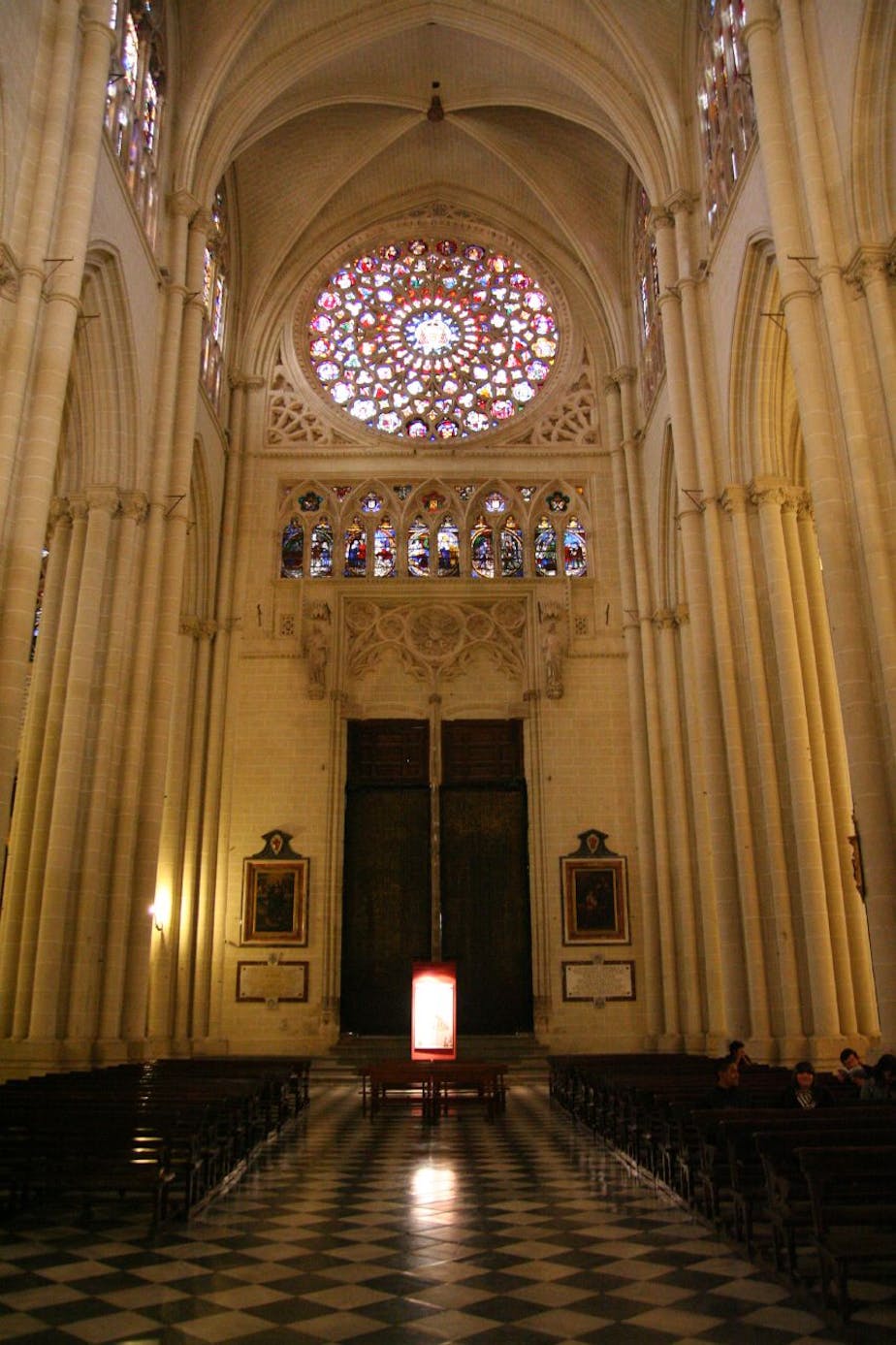




Sharp Objects
After the cathedral we came upon a great knife shop, where David was like a kid in a candy store. After some window shopping, we went inside where I was happy to warm up and browse while David talked with the shop owner (a rare English-speaker) and handled some knives he'd only ever seen on the Internet.
If it weren't for our limited time, shipping and VAT issues, and the fact that most knives are illegal in Britain (except for kitchen knives, which people stab each other with just fine), we would have left with a couple.
Synagogues of Toledo
Our next stop was to Toledo's two wonderful synagogues, which were converted into churches after the Catholic monarchy expelled the Jews from Spain in 1492. Fortunately, the original architecture was almost completely preserved during the transition and they are great examples of the unique style of architecture from Andalusia (southern Spain), which can be found from Toledo all the way down to Morocco.

Andalusian architecture developed from the blending of civilizations that successively occupied this area - first was the Visigoths, "barbarians" from the north who were Arian (heretical) Christians and are credited with inventing the horseshoe arch. They were followed by several successive Islamic dynasties, who brought their own Arabic and North African influences.
After the Catholics took over in the 15th century, a few mosques and buildings from earlier eras survived (such as these synagogues), but the art also lived on through the Muslim converts or pseudo-converts who stayed in Spain and decorated churches and other buildings. Work by such artists is known as "Mudejar." This mixing of Visigothic, Islamic and Catholic styles shows up again and again throughout our trip, and I found it to be very beautiful and unique.
The first Toledo synagogue we visited was Santa Maria la Blanca, which is obviously the name it was given after it became a church. The "La Blanca" part comes from the white arches that dominate in the interior. The synagogue was founded in 1203 and was designed by Moorish (Mudejar) architects, with the result that it looks much more like a mosque than a synagogue. We both loved it.

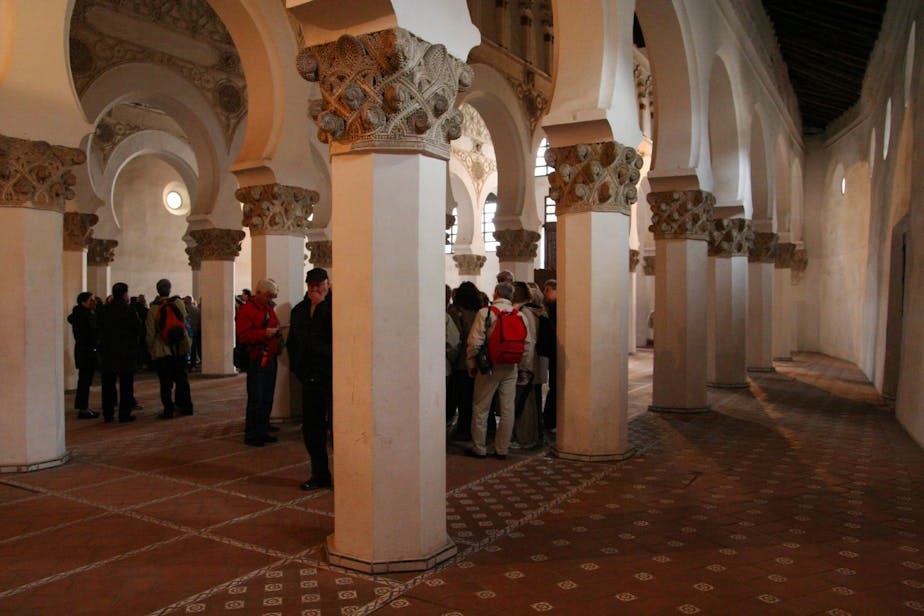
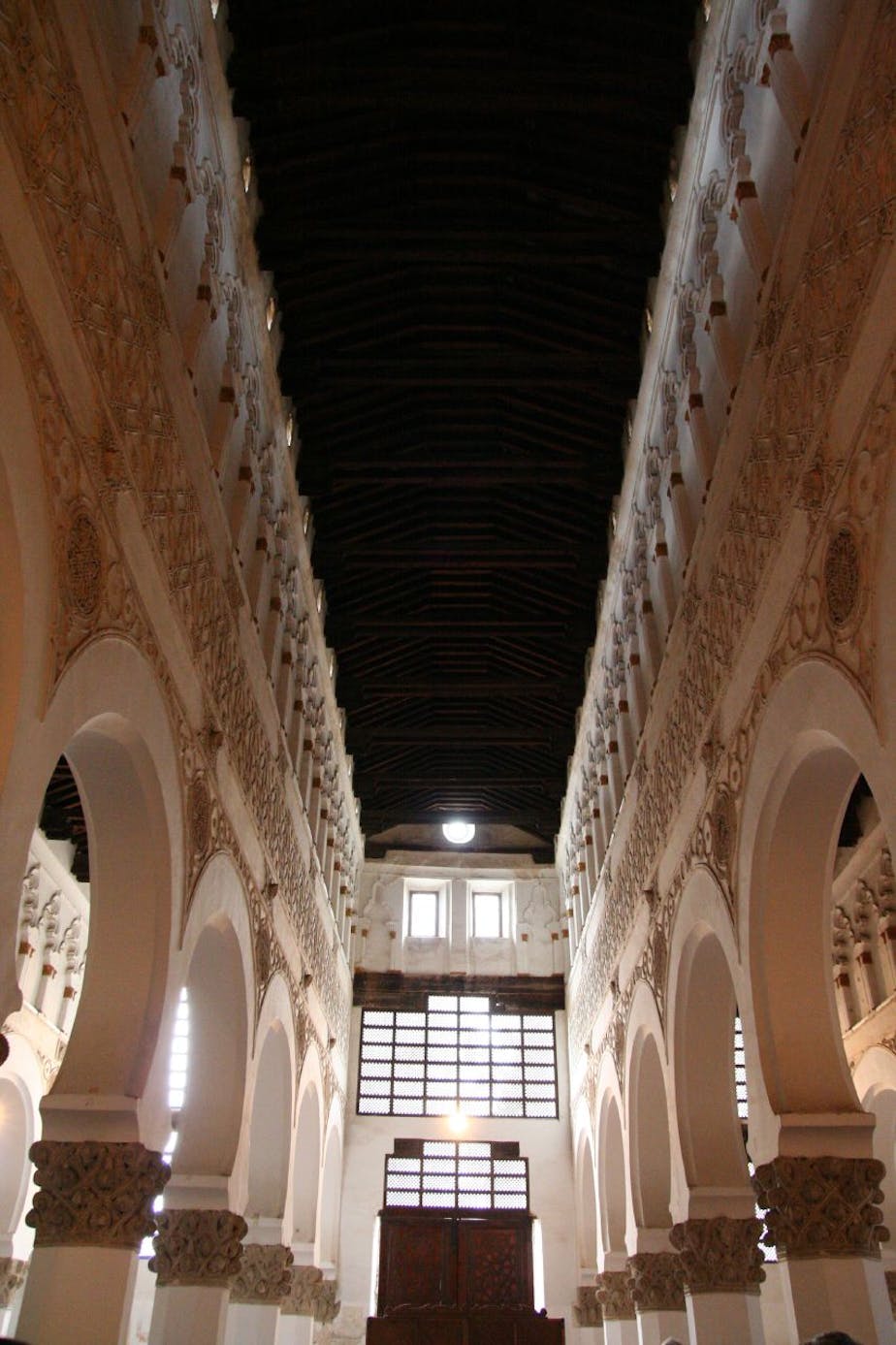





By the way, my hood's up in the photo above not because of any rule to cover heads, but because it was so darn cold! It was ridiculously cold outside, and it was rarely any better inside the various sights because they are mostly made of stone and aren't heated (understandably). In fact, it was often even colder inside because of the lack of sun. Didn't we fly south to enjoy warmer weather?? We consoled ourselves with the thought that we were heading much further south that evening, surely it will be warmer then... (spoiler alert: not so much).
Just down the road from Maria la Blanca is Toledo's other medieval synagogue, which dates from the 14th century (200 years later) and is called Sinagoga del Transito.
This one is a lot different - instead of all the arches, it's just a large open room decorated with intricately carved walls and Hebrew inscriptions. The beautiful ceiling is said to be made from cedars of Lebanon, just like Solomon's Temple. Overlooking it all is a women's gallery, which also has beautiful carvings and provides nice views of the main room.

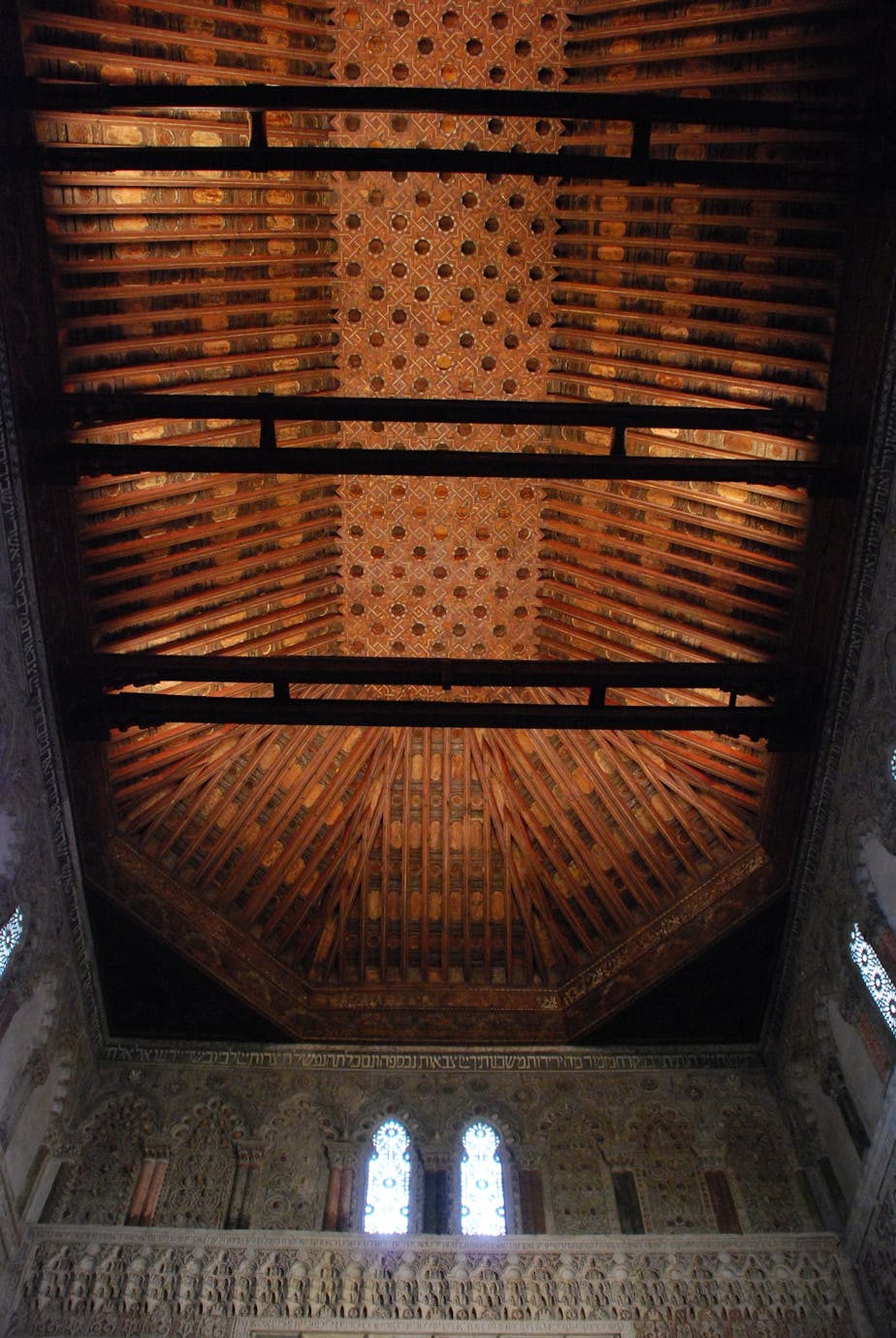

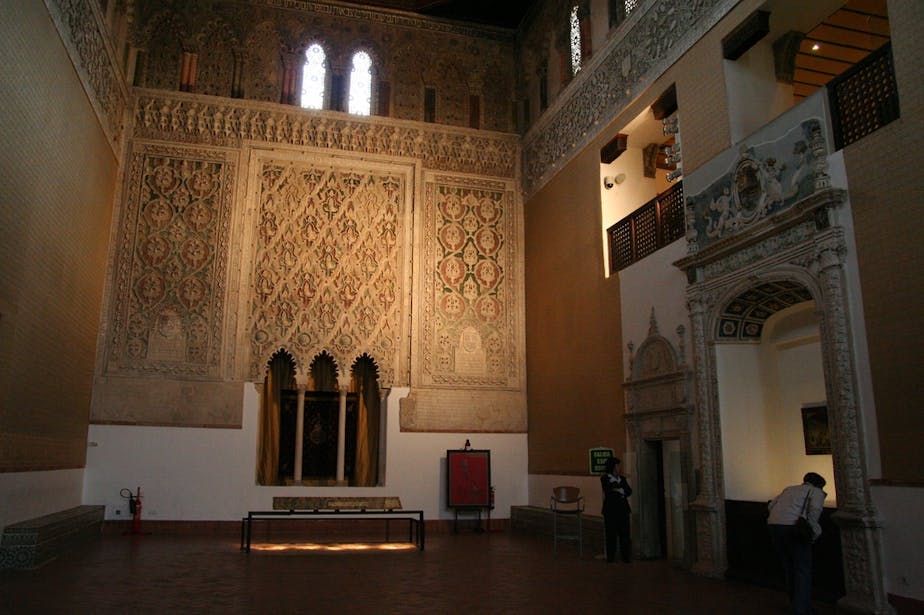

The synagogue also includes a small Jewish museum, which has medieval religious objects along with more ancient artifacts:





As a bonus, just across the street from the synagogue is a marvelous view across the river:

San Juan de Los Reyes
Next up is the church and monastery of San Juan de Los Reyes ("St. John of the Royals"), a Franciscan convent founded by Ferdinand and Isabella to celebrate a big victory over the Moors. They also planned to be buried here and decorated it accordingly, until they captured Granada and decided that was an even more fabulous resting place.
The large church (photos prohibited but unenforced) is nice, but the highlight is the two-story cloister with central garden, orange trees and gargoyles. Sadly the weather turned gray at this point, so the pictures aren't as pretty as they could be.








One often-mentioned feature of this monastery is its unique decorative use of leg-irons on the exterior, which were supposedly used to imprison Christians in Granada during Muslim rule. We looked all over for these and never found them - we suspect they were beneath a large part of the building that was under renovation.
A Jesuit Church with Nice Views
From the monastery we began to make a general heading back in the direction of the bus station, although we still had a couple hours to spend before our 5:25 train to Madrid. Along the way we came across a large church, and of course we peeked into it.
It turned out to be a relatively new Jesuit church, which was nice but not terribly interesting. I turned around to head back out - only to see David buying admission tickets! He said we had to at least have a quick look around. I love the enthusiasm! So we did, and saw some nice, golden altars and religious artworks which were attractive against the white walls. It reminded me a lot of the Jesuit church I briefly ran into in Lucerne.

Then as we both tried to head out, the man at the desk insisted in Spanish that we go up the towers and would hardly let us leave without doing so. So we obediently trucked upstairs, and it was worth it! We had some very nice views of the nearby cathedral, the Alcazar, and pretty much all of Toledo. It's where we took the picture at the top of this blog post.
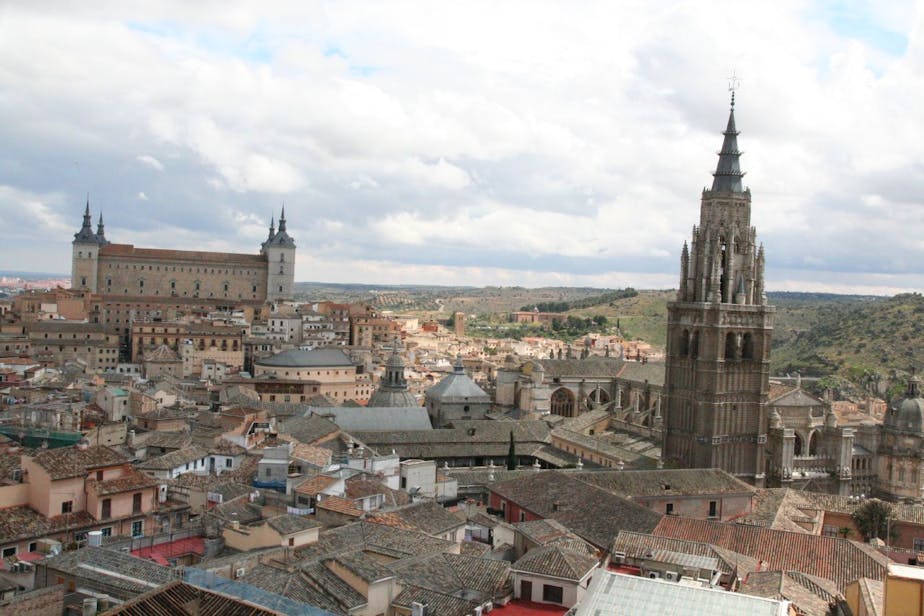
Lunch and the Search for San Roman Church

While David checked out another knife shop next door (incidentally not as good as the first one), I got us Diet Cokes and two sandwiches con queso. They were very simple - nothing but a baguette and cheese - yet quite delicious and gave us the energy to press on until our train time.
We found a lovely little plaza just up the hill and enjoyed a rare relaxing moment in between the high-speed sightseeing. It was wonderful.

The next goal was then to visit Iglesia San Roman, an old church which now houses the Museo Visigoto (Visigothic Museum). I had seen photos while researching it for my website and it looked really interesting. Our guidebook also called it "the most interesting church in Toledo."
Unfortunately, our guidebook (Rough Guide to Spain) also put it on the wrong side of the street on its map, and I didn't know what it looked like on the outside. So we spent the good part of an hour on a ridiculous goose chase in the area, asking several people, staring at the compass, and examining several churches that were not it. In the end, it was right around the corner from the Jesuit church and we passed it several times, thinking it wasn't it. D'oh! And it was closed anyway. Argh.
Mezquita del Cristo de la Luz
We had more luck with our final sight in Toledo, an interesting little mosque called Mezquita del Cristo de la Luz (Mosque of Christ of the Light). Why is a mosque named after Christ? Because, just like the synagogues, it was later converted into a church. The "light" of the title refers to a legend that after the Reconquista, an image of Christ was discovered hidden in the mosque - and it had been miraculously lit by a lantern throughout the centuries of Muslim rule. And why would an image of Christ have been in a mosque? Because the mosque itself was built over a Visigothic church.



Legends aside, the Mezquita is a fascinating little building. It is also one of the oldest Moorish monuments in Spain, having been built in the 10th century. Unfortunately it was under major restoration works during our visit, but at least we were still allowed in (for an admission fee).
It was frustrating not to be able to go all the way in due to the construction, because we could just catch glimpses into the interesting apse and of great faded murals from its period as a church.
From the brochure that came with our tickets I learned that there was a nifty old mural of Christ on the ceiling of the apse, but alas it was completely out of sight. One consolation, however, was that admission to the mezquita included some peaceful little gardens off to the side as well as easy access to some nice views of a large city gate (Puerta del Sol) and over the northern edge of the city walls.
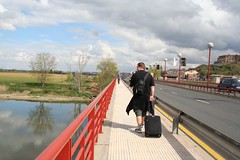 And it was from here that we began our descent from the old city down towards the bus station to collect our luggage. Then it was back across the bridge (right), and after a much longer walk than I remembered (a good 15-20 minutes carrying a backpack), back to the train station.
And it was from here that we began our descent from the old city down towards the bus station to collect our luggage. Then it was back across the bridge (right), and after a much longer walk than I remembered (a good 15-20 minutes carrying a backpack), back to the train station.
We had some time to spare before our 5:25 train so we had a quick snack at its cafe, including fried calamari (like rubber) and fries (good), before getting back on the lovely train. We had an hour layover in the Madrid train station, which is pretty nice but the bathrooms aren't, and then it was off to Seville on the 7:00 train.






